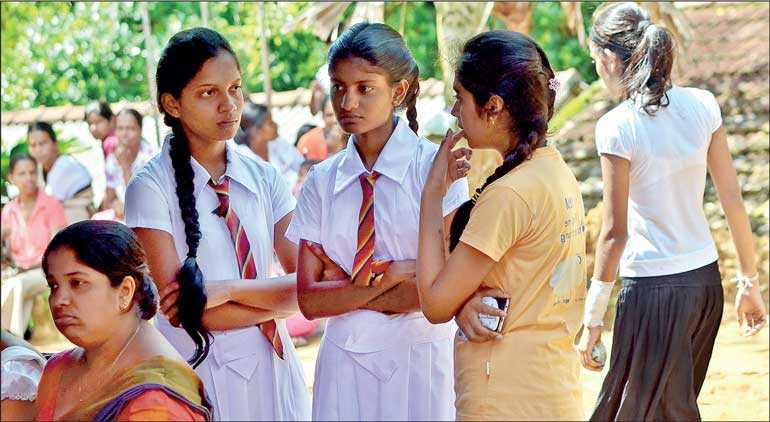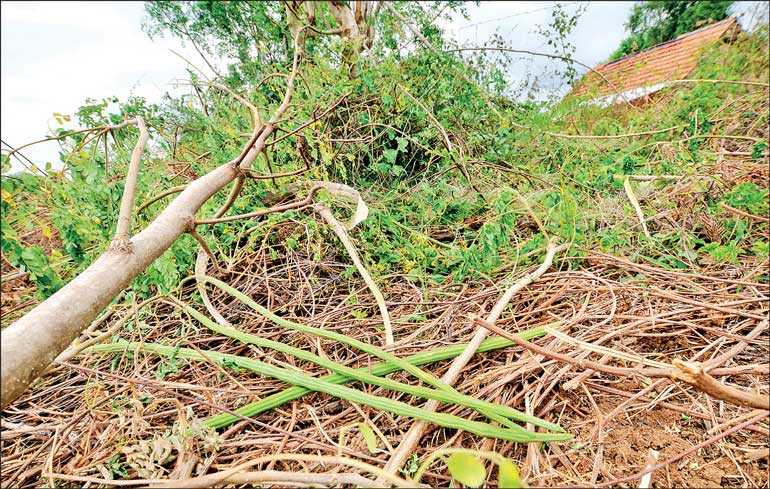Thursday Apr 24, 2025
Thursday Apr 24, 2025
Friday, 8 February 2019 00:10 - - {{hitsCtrl.values.hits}}


Sri Lanka is in a state of backwardness and confusion in terms of its knowledge on things as well as the way it thinks. This backwardness and confusion can be seen rooted even in accepted policies of far-reaching consequences – so much so that it has become a common characteristic and a general trend in almost all sectors.
It can also be considered a topic that has not received due attention or been subjected to debate despite it being a significant factor which has adversely affected the progress of the country in many respects. This article intends to explore the way these two factors have resulted in the low progress and downfall of two important sectors, namely education and agriculture.
 However, I wish the reader to treat this article only as a general review intended to draw the attention of the authorities concerned and the general public to these two areas rather than provide a comprehensive review of the subject.
However, I wish the reader to treat this article only as a general review intended to draw the attention of the authorities concerned and the general public to these two areas rather than provide a comprehensive review of the subject.
Progress made in mathematics
Over a considerable period of time, the rate of students failing in mathematics at the GCE O/L examination remained as high as 65%. Surprisingly, the progress shown in the results of this subject now stands at a very high and exceptional level. Presently, the situation is reversed with the rate of failures coming down to 35% and that of the passes received going up to 65%.
This sudden progress is not an outcome of a gradual progress in the competency of the subject knowledge; nor is it due to an improvement in the teaching techniques either. It is only an outcome of lowering the level of pass marks to as low as 29. This cannot be considered a sound policy that leads to the benefit of students in the long run except for their backwardness and downfall.
The strange thing is that the lowering of the level of pass marks has not generated any opposition or shock among educationists and parents. Instead, it has received the approbation of everyone, so much so that this can be presumed to be the way Sri Lanka rectifies its mistakes.
Over a very long period, the GCE O/L examination was commenced on a Monday. The former Commissioner General of Examinations changed this date to a Tuesday, creating a new tradition. A Member of Parliament had the reason clarified with the Commissioner General of Examinations for changing the date from Monday to Tuesday, which he reported to the Parliament at the same time, creating a pleasant impression on the raison d’être of the Commissioner General of his decision.
According to his explanation, the Commissioner General of Examinations had changed the date from Monday to Tuesday on astrological reasons considering the adverse impact of Rahu kaalaya that prevails at the time of the commencement of the examination on Mondays. Rahu is considered an inauspicious planet and the time under its influence should be avoided in doing any auspicious work. So, he has changed the date in good faith to rescue students sitting for the examination from adverse impact of Rahu.
If this learned Commissioner of Examinations, by some chance, had happened to be the head of the Civil Aviation Authority, the Colombo airport would have been made the only astrological airport in the world that operates air travel taking into account the time of Rahu and the direction in which Mara stands. 
This illustrates the degree of freedom enjoyed by people who hold important positions in the administration of the country in managing the institutions under their jurisdiction according to baseless and idiosyncratic beliefs held by them.
There is a practice in schools today in directing students who sit for public examinations to take a vow invoking the blessings of supernatural forces for successful performance in examinations. The teachers themselves take the lead in taking students in groups to the churches, temples and kovils of their choice for this purpose. It can be described as a ritual followed by schools with official approval of the authorities. In some areas, pens that are supposedly magically charmed and blessed with supernatural powers are distributed among students sitting for public examinations.
Such programs are often conducted with the approval and connivance of the school authorities. The extent of degeneration of the education system in Sri Lanka can be discerned from these mythical and superstitious practices associated with examinations.
The object of school education ought to be to disseminate useful worldly knowledge, conducive to building a successful life in this world, rather than sacrificing the present life for a better life in an otherworld. But, the school system in Sri Lanka can be said to have become an institution that promotes credence in paranormal issues and superstitious beliefs among students. The most important point here is that this gullible system which promotes beliefs in primitive superstitions among students has not become a matter of concern and objection of media, the academics or the learned parents.
It appears that rote learning, memorisation based on repetition, has become the main focus of disseminating knowledge to the students in Sri Lanka. The entire school system is based on this system. In the long past, when there were no written languages, the knowledge of one generation was transmitted to the next by memorising the information. This method was known as oral tradition. The system adopted in Sri Lankan schools today in disseminating knowledge to students is more or less similar to the oral tradition adopted in the past.
Accordingly, in Sri Lanka, the students have got accustomed to memorising the knowledge transmitted by their teachers instead of exploring knowledge through critical review and analysis on their own and by themselves. This is a wicked system that kills the creative abilities of the students, but it does not seem to have caused any objection or anxiety in the people.
The school system
The school system can be cited as the best example to illustrate the confusion in the way Sri Lanka thinks. It has become a complex issue when it remains a matter that could be solved easily.
In all developed countries where a sound system of education exists, all schools are classified as primary, secondary and tertiary schools. The new entrants to the school education system should select a school from among two or three schools situated closer to their homes. The quality of almost all schools is more or less the same. There is hardly any competition to enter into a primary school.
But the situation in Sri Lanka is totally different. In most cases, the mother and the father are compelled to be concerned with the problem of finding a school for the child from the moment she is conceived. In order to find a good school for the child, they have to build false evidence, in most cases incurring a very high cost, to obtain an address closer to the school. Yet, it is only a very few who would be successful in achieving the objective even after paying a substantial bribe. I need not reiterate that this is an extremely uncivilised practice.
The informal system of classification of schools in Sri Lanka, while limiting the chances available for poor people to come up in life through education, has attached a class division to the school system; besides that it has rendered the student enrolment process to a school, an extremely a corrupt system. This complex problem can be easily solved by abolishing the unjust classification of the present system of schools as high and low by introducing a simple system that recognises all schools as equal in status. It would not be difficult to introduce a primary school system from Grade 1-5, secondary school system from Grade 6-11 and higher school system from Grade 12-13.
A study made by me in 2010 revealed that if all schools are classified into three broad categories as primary, secondary and higher schools, the category of primary schools will have 7,000 schools or 72% of the total number of schools with each school having 233 students and 9.65 teachers on average. The number of secondary schools from Grade 6-11 will be 2,000 or 23% of the total number of schools. The average student population per school will be 945 and the number of teachers 68.64 per school. The number of higher schools will stand at 662 or 7% of the total number of schools. The average student population per school will be 662 and the number of teachers 32.01 per school.
Such a reform in the school system will certainly lead to remove the present discriminative classification of schools as high and low and make all schools equal, to a great extent, in terms of the standard of the quality of education and social acceptance. The persistent struggle made to enter a child into a selected few schools and the corruption associated with it can be eliminated.
Such a system will make the management, administration and supervision of schools easy. It will not only facilitate the formalisation of the distribution of resources but also make it easy to optimise the distribution of academic staff as well. It will make it easy for the principals to manage the school and the teachers to manage the classroom.
As all students in primary classes are educated in a school closer to their homes it enables the students to reach the school even without being accompanied by their parents. It will also help the parents to reduce the cost of transportation incurred in educating their children. The time spent in travelling by bus or other mode of transportation will be reduced. The traffic congestion on roads can be reduced. The present trend of well to do people migrating to cities for the education of their children, selling their properties in rural areas, can be discouraged.
The National Education Commission of Sri Lanka too has recommended such reforms for the school system. But the political authority or the old boys and girls associations of schools do not wish to see such a change. It is not difficult to understand the reason for their resistance to change in the present system.
Agriculture and wild animals
Several examples can be cited from the field of agriculture also to illustrate the confusion inherent in the way the Sri Lanka thinks, but I would like to comment only on the policy in regard to the material issues associated with the damages caused to agricultural sector by insects and wild animals.
The Sena caterpillar has become the main topic of discussion in agriculture today. This caterpillar has already done serious damage to the corn cultivation of Sri Lanka. Obviously, it can be a threat to paddy and vegetable cultivation as well. The issue of the Sena caterpillar is a big problem to be solved immediately. But we must not forget that the Sena caterpillar is not the only creature that causes damage to agriculture.
The Government has officially reported that the damaged caused by wild animals to agriculture in Sri Lanka remains as high as 40%. Monkeys, small brown monkeys or rilavun, wild boars, peacocks, porcupines and elephants are among the major animals who have become a serious threat to our agriculture.
A country needs wild animals. There should be a consistent policy to protect them. But, the Government has a responsibility to control the high growth of certain species of animals that pose a threat to the agricultural product of the country. Many countries have adopted a policy of authorising people to hunt animals which have a high rate of growth or the Government assumes the responsibility of destroying the surplus growth by itself. The kangaroo is the national symbol of Australia. Yet, at present, there is a policy in use in Australia in which kangaroos are shot to control the excess growth of the species and the meat sold public consumption with any excess being used as animal food.
Whether we eat it or not, meat has a big economic value. Countries which do not exploit this resource can be considered as ignorant countries. India is a Hindu country. The Hindus do not consume beef. But India does not allow the beef that it does not consume to go waste. India is ranked the largest beef exporter in the world. In 2014, India exported 2,089,000 metric tons of beef. The income earned in beef export was $ 4,781.18 million.
The damage caused by wild animals to agriculture in Sri Lanka has increased due to lack of a consistent Government policy for controlling the dense growth of animal population. The Government is prepared to kill the people who rebel against the Government. But, the Government is hesitant to kill the wild animals that cause great damage to agriculture and have a high density of growth.
Also, the Government is not prepared to allow the people to hunt them. The policy of the Government in regard to this issue I must say is not only ignorant but also ludicrous. Killing of wild boar is not prohibited by law. But possession, selling and transportation of wild boar meat had been prohibited.
In response to a consistent clamour made by the Punarudaya movement, the Government declared a policy authorising the possession, selling and transportation of wild boar meat. Consequent to this new policy, the price of wild boar meat fell down to Rs. 300 per kilo while the sale of it became an open thing. However, as the relevant gazette notification was not published amidst the crisis that arose in the face of the recent change of the Government, the relevant wildlife officials made it an opportunity to adopt a rigid policy against the hunters and the traders of wild boar. This illustrates the true nature of the way the bureaucracy of Sri Lanka operates.
How is it possible that the possession, selling and transportation of the meat is illegal if the killing of wild boar is not prohibited? Does it imply that the hunter should consume part of it and the remainder of the killed animal is buried without selling its meat?
We must not forget that Sri Lanka has a high level of malnutrition. Professor K. Samarasinha of University of Peradeniya, in an interview with a newspaper, had indicated that protein malnutrition in Sri Lanka is as high as 30%. In fact, meat consumption in Sri Lanka remains at a very low level.
Animal protein is an essential requirement for the development of the brain of small children. Perhaps Sri Lanka may be the only Buddhist country where consumption of meat is considered a sin. While per capita meat consumption per annum in Sri Lanka is 6.3 kilograms, it remains at 16.6 kg in Cambodia, 25.8 in Thailand, 28.3 in Myanmar, 45.9 in Japan and 49.9 in Vietnam, all of which are Buddhist countries. The low intelligence level apparent in Sri Lanka by international standards may have some connection with the low rate of consumption of meat and the practice of abstaining from consumption of meat.
Sri Lanka, if it chooses, can make use of the surplus of animals to overcome the protein deficiency in the food intake and malnutrition of the people. Permission should be granted to hunt animals that damage agriculture except elephants and lift the ban on possession, transportation and selling of their meat. The meat that we do not consume in Sri Lanka can be sold to other countries which have demand for them.
In doing so, Sri Lanka, which has become economically bankrupt, can make the surplus supply of wild animals a lucrative source of income generation whilst at the same time solving the problem of high density growth of certain animal species.
Pix by Shehan Gunasekara
Discover Kapruka, the leading online shopping platform in Sri Lanka, where you can conveniently send Gifts and Flowers to your loved ones for any event including Valentine ’s Day. Explore a wide range of popular Shopping Categories on Kapruka, including Toys, Groceries, Electronics, Birthday Cakes, Fruits, Chocolates, Flower Bouquets, Clothing, Watches, Lingerie, Gift Sets and Jewellery. Also if you’re interested in selling with Kapruka, Partner Central by Kapruka is the best solution to start with. Moreover, through Kapruka Global Shop, you can also enjoy the convenience of purchasing products from renowned platforms like Amazon and eBay and have them delivered to Sri Lanka.
Discover Kapruka, the leading online shopping platform in Sri Lanka, where you can conveniently send Gifts and Flowers to your loved ones for any event including Valentine ’s Day. Explore a wide range of popular Shopping Categories on Kapruka, including Toys, Groceries, Electronics, Birthday Cakes, Fruits, Chocolates, Flower Bouquets, Clothing, Watches, Lingerie, Gift Sets and Jewellery. Also if you’re interested in selling with Kapruka, Partner Central by Kapruka is the best solution to start with. Moreover, through Kapruka Global Shop, you can also enjoy the convenience of purchasing products from renowned platforms like Amazon and eBay and have them delivered to Sri Lanka.